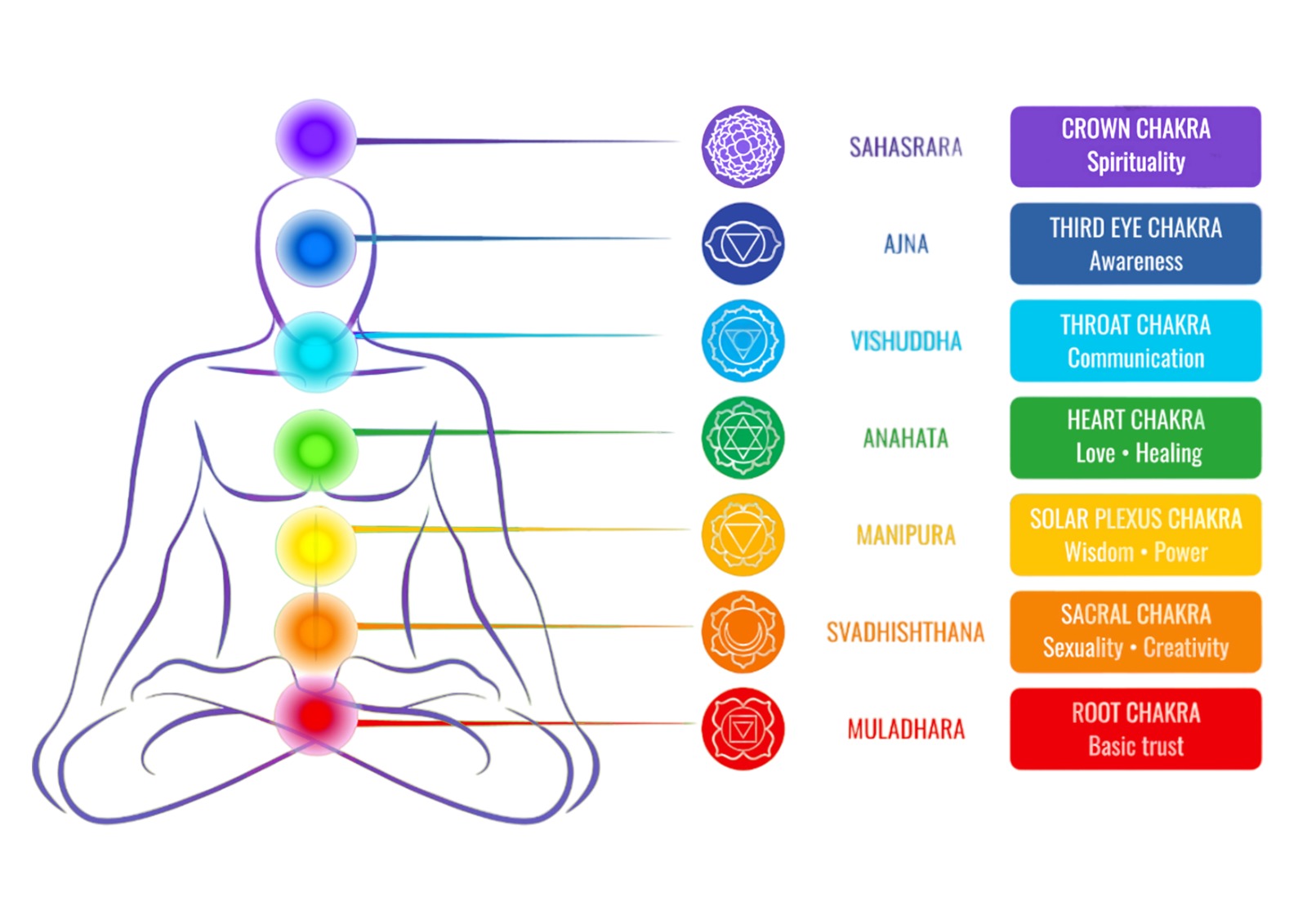What is chakra?
“Chakra” is a Sanskrit term, translating to “wheel” or “circle,” rooted in the ancient Indian yoga system. They are best defined as energy vortexes aligned vertically along the spine, corresponding to the spinal plexuses in the physical body.
Each chakra resembles a spinning disk of light, turning clockwise at varying speeds. Within your physical body, seven major chakras are present.
Just like the brain regulates the physical, mental, and intellectual activities of the nerve cells, chakras tap into the prana energy that is present in all living organisms.
WHY are chakras important?
Consider chakras as fundamental elements in your spiritual odyssey, offering valuable insights to enhance the integration of your mind, body, and spirit. Understanding these energy centers can be a transformative key to achieving a more harmonious and interconnected sense of self.
Think of your body like a vehicle, and the chakras as the wheels steering you towards enlightenment. Balancing these energy centers helps guide your journey to a more aware and enlightened self.
HOW DO CHAKRAS WORK?
Chakras are intricate energy pathways in our body, serving as the spiritual nervous system. Think of them as spinning circles of energy that can impact both your physical and emotional well-being.
HOW DO CHAKRaS GET BLOCKED?
Chakras, much like gateways or channels, have the potential to become blocked, constricted, or closed. When a chakra is blocked, it signifies trapped or restricted energy—a concept analogous to a clogged artery in your body.
How do i know if my chakras blocked?
If all your chakras are blocked you may experience physical, mental, and emotional symptoms such as depression, anxiety, lack of focus, difficulty sleeping & physical pain
How to unblock chakras
Best ways to unblock your seven chakras:
- Meditation
- Asanas (yoga)
- breath control
- Mudras
- Bandhas
- colors
- Beejaksharas
- Ragas

THE ROOT CHAKRA
The Root Chakra (Muladhara), situated at the base of the spine, serves as the foundational energy center in the human body. This chakra lays the groundwork for constructing a life and embodies essential qualities such as safety, stability, comfort, and security. It functions as the cornerstone of the entire chakra system, providing the support upon which other chakras rest. Additionally, the Root Chakra houses the dormant Kundalini, the life force, awaiting awakening to empower individuals to navigate the material world.

Sacral Chakra
The Sacral Chakra (Svadhishthana), positioned around the navel area, is the second chakra in the human body. This chakra plays a crucial role in fostering the balanced expression of emotions and influences one’s capacity to connect with oneself and others. Serving as the primary hub of creativity and emotional intelligence, the Sacral Chakra holds a distinctive focus on sexuality, recognizing sexual energy as one of the most potent forces within our beings.

The Solar Plexus
The Solar Plexus Chakra (Manipura), situated in the stomach area, represents the third chakra in the human body. Visualized as a radiant, yellow Sun, this chakra emanates energy through the core, governing every facet of personal power. Functioning as the focal point for personal identity, the Solar Plexus Chakra influences aspects of personality, self-esteem, and ego, establishing a profound connection to one’s individuality.

The Heart Chakra
The Heart Chakra (Anahata), positioned in the chest area, serves as the fourth chakra in the human body, symbolizing love, acceptance, and compassion. Acting as the sanctuary for our spirit, the heart chakra thrives on the primary energy of love. Nurturing self-acceptance and embracing self-love provides a strong foundation for cultivating a vibrant and healthy heart chakra.

The Throat Chakra
The Throat Chakra (Vishuddha), residing at the center of the neck, signifies the fifth chakra in our body, emphasizing the capacity to articulate thoughts clearly and engage in effective communication. This chakra acts as the seat of purification, with its associated element being ether, also referred to as Akasha or spirit. Ether, a subtle and non-physical element, transcends the material realms of earth, air, fire, and water, serving as the boundary between the material and astral universes. The throat chakra holds sway over communication, shaping our reality and facilitating the manifestation of our intentions into the physical world. Communication, viewed as a rhythmic and connective activity, involves both listening and speaking.

The Third Eye Chakra
The Third Eye Chakra (Ajna), positioned as the sixth chakra between the eyebrows in the center of the forehead, serves as your spiritual hub for awareness and intuition. Its associated element is light, characterized by a faster vibration than sound. Ajna, the Sanskrit name for the third eye chakra, conveys both ‘to perceive’ and ‘to command.’ Individuals with a well-developed third eye chakra often exhibit heightened visualization abilities. Serving as the primary gateway, the third eye chakra allows access to higher knowledge and transcending duality. An opened and awakened third eye chakra empowers individuals to explore extrasensory perceptions, including clairvoyance and telepathy.

The Crown Chakra
The Crown Chakra (Sahasrara), situated as the seventh chakra at the pinnacle of the head, derives its name from ‘thousandfold,’ symbolized by a thousand-petaled lotus, signifying the realm of higher consciousness and divine connection. The progression of the crown chakra culminates in profound transformation, self-realization, and enlightenment. Functioning as a juncture between the finite and the infinite, the crown chakra invites individuals to transcend their current understanding and embark on a journey of spiritual exploration.
